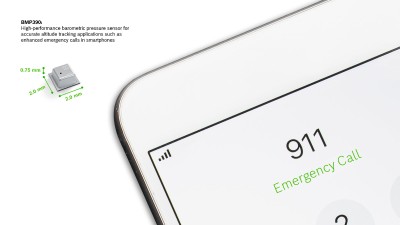Accurate indoor localization can save thousands of lives -
enabled by pressure sensing solution
Bosch launches barometric pressure sensor BMP390 for smartphones, wearable and hearable devices
- Best performance on the market due to unique accuracy and temperature stability
- Ideally suited for smartphones, hearables and wearables thanks to low package height
- Enables accurate indoor localization with smartphones in case of emergencies
- FCC estimates addition of vertical-specific information could save up to ten thousand lives per year

Bosch Sensortec announces the BMP390, a barometric pressure sensor that delivers unmatched accuracy for altitude tracking in smartphones as well as wearable and hearable devices. The new sensor can measure height changes below 10 centimeters thanks to the improved resolution, and is 50 percent more accurate than its predecessor.
Accurate altitude detection helps to localize people indoors, where GPS signals are not available. The addition of the vertical-specific position to existing horizontal information enables first responders to determine the floor level of smartphone users who trigger an emergency call. The Federal Communications Commission (FCC) estimates that the additional vertical information has the potential to save up to 10,000 lives per year just in the USA alone.

Enabling enhanced emergency calls
According to a recent report by the FCC, wireless providers in the US will soon be required to meet an increasingly stringent series of location accuracy benchmarks in accordance with a timetable, including providing the caller’s dispatchable location. The order adopts a z-axis location accuracy metric of ±3 meters relative to the handset for 80 percent of indoor wireless 9-1-1 calls starting in 2021. Emergency applications such as the enhanced 911 (E911) system in the US could also be implemented in other regions like Europe or Asia, to further improve people’s safety and peace of mind.
Bosch and NextNav LLC, a 3D geolocation service provider, have collaborated on component specifications and system performance resulting in consistent, high accuracy z-axis capabilities indoors. This is accomplished by applying barometric pressure sensors in the phone, like the Bosch BMP390, and combining them with NextNav’s Metropolitan Beacon System (MBS) z-axis service to determine three-dimensional location and positioning.
Accurate indoor and outdoor navigation and improved fitness tracking
Not limited to emergency applications, the sensor also enables improved indoor navigation in general, for example in combination with the Position Tracking Smart Sensor BHI160BP. These navigation solutions compensate for traditional localization technologies such as GPS that do not work efficiently in shielded environments. This will help users to save time and avoid the hassle of getting lost, for example when searching for their car in an underground garage.
Furthermore, the new BMP390 supports enhanced GPS applications for outdoor navigation and calorie expenditure estimation tasks. The use of advanced barometric pressure sensing can determine whether a user is walking up or down an incline, stairs or lifting weights during a fitness training session. This helps to increase the precision of calorie tracking by up to 15 percent. Thanks to the improved accuracy of altitude measurements, fitness trackers are able to show exactly how far a user has run, walked or cycled.

Accurate, stable and compact
The BMP390 provides a typical relative accuracy of ±0.03 hPa, which is superior to any other comparable product on the market today. Typical absolute accuracy is ±0.5 hPa. The excellent accuracy is the result of significant improvements in temperature stability, drift behavior and noise. The sensor offers high temperature stability across its entire operating temperature and pressure range of 0 to 65 °C and 700 to 1100 hPa respectively, with an average temperature coefficient offset (TCO) of just ±0.6 Pa/K. Noise is also low, at only 0.9 Pa typical, an improvement of 25 percent relative to the predecessor BMP380. The device also provides high long-term stability, and low short- and long-term drift.
Its small size, measuring only 2.0 mm x 2.0 mm x 0.75 mm, makes the new sensor easy to integrate into portable devices. Power consumption is kept low at 3.2 μA at 1 Hz (typical) to maximize battery life on portable devices.
Availability
The BMP390 is available for high-volume smartphone, wearable and hearable manufacturers.
Discover how the pressure sensor works:
Loading the video requires your consent. If you agree by clicking on the Play icon, the video will load and data will be transmitted to Google as well as information will be accessed and stored by Google on your device. Google may be able to link these data or information with existing data.